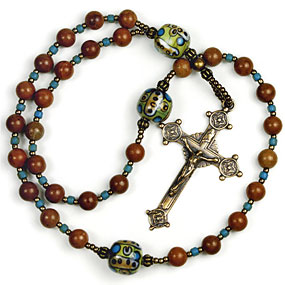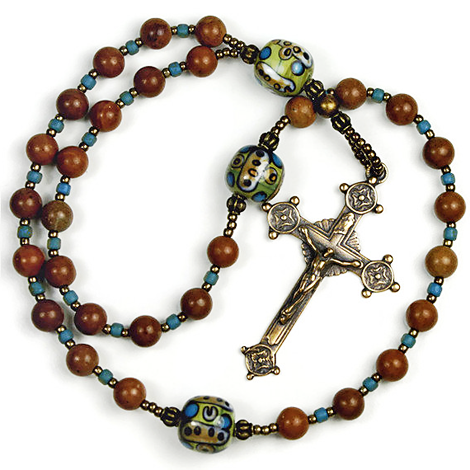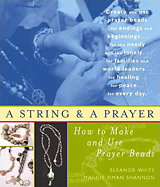  Russian Orthodox Chotki Russian Orthodox Chotki |
Christian prayer beads, most recognizable as the Catholic rosary, are usually made of colored glass or plastic beads, or sometimes beads crafted of olive wood. Although there are roots to the prayer practices of the Desert Mothers and Fathers in the third century, prayer bead use was more widely developed in the sixth century. Then, Saint Benedict of Nursia asked his disciples to pray the 150 Psalms of the Bible at least once a week. Since this was a large assignment for the memory, a substitution of 150 Paters ("Our Fathers") was allowed. The faithful used beads to count the paters, and this string of 150 beads became known as a paternoster. It might surprise some who associate Lady Godiva only with unusual horsemanship, but the first recorded mention of Christian prayer beads occurs in her will. She bequeathed her paternoster beads of precious gemstones to the convent she founded in 1057.
The person widely believed to have introduced prayer beads as Christians know them today is Saint Dominic, after he had a visitation by the Blessed Virgin Mary; and Thomas of Cantimpre first called them a rosary, from the word rosarium or "rose garden," since the faithful used strung rose petals and beads made of crushed rose petals to count prayers. When using a rosary—which is divided into groups of ten beads, called decades—in traditional practice, a Catholic repeats the "Our Father" and "Hail Mary" prayers as she marks off the beads with the fingers while meditating on the life of Jesus and Mary.
In the Eastern Orthodox tradition, both knots and beads are used. Shorter knotted ropes are worn on the wrist. Often made of wool, the Greek prayer ropes—called kombologion—have 33, 50, or 100 knots. Russian chotki have 33, 100, or 500 knots. Sometimes the faithful use bead strands resembling a ladder (each end of a bead touching two parallel strands), which signifies the soul making its ascent to heaven.
Christian prayer beads probably once had relationships to the folklore surrounding stones and talismans. Coral, for example, was thought to guard against illness, so in many portraits of Jesus Christ as a child, he is depicted with coral beads. Later, as a result of such associations, clergy were not allowed to use rosaries with beads made of amber, quartz, or coral.
Christian prayer beads have been associated primarily with Roman Catholicism or with the Greek and Russian Orthodox tradition, because John Calvin discouraged their use by Protestant believers. He rejected materialism and ritual, feeling that the faithful should read and analyze spiritual texts in direct relationship with God, rather than simply memorize set prayers.
However, in the late 1980s, an Episcopalian priest created an Anglican rosary of 33 beads, which represent the years of Jesus' earth life. There's also a non-denominational variation known as the "Earth Rosary." Consisting of four sets of 13 beads, which indicate the thirteen weeks in each of the four seasons, the Earth Rosary has a total of 52 beads, representing each week of the year.
Like their secular counterpart "worry beads," prayer beads offer a kinesthetic comfort—they are a means in the material world to remember one's place in the spiritual world. As M. Basil Pennington reminds us in Praying by Hand: Rediscovering the Rosary as a Way of Prayer, prayer beads simply are a method or instrument "to help us pray, to enter into communion and union with God. Therefore, we should feel free to use it or pray it in any way that helps us to enter into that union."
Christianity » Religious Use of Beads » History of Prayer Beads » A String & A Prayer: How to Make & Use Prayer Beads
Eleanor Wiley and Maggie Oman Shannon (2007) Red Wheel/Weiser, LLC


